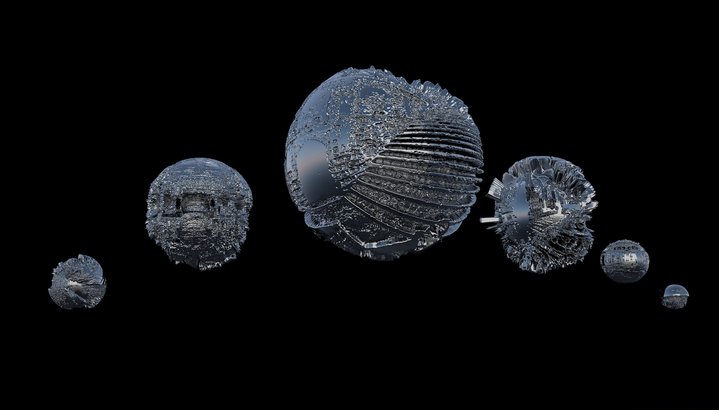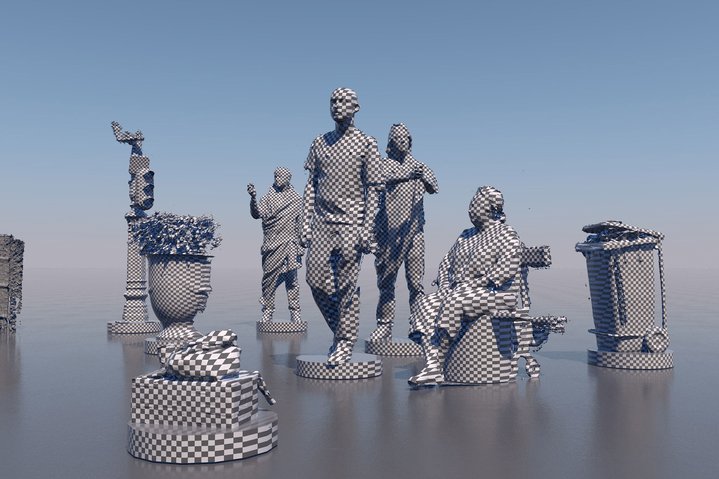Technocratic Renaissance: a Recycle Group and their digital religion

The dynamic duo from Krasnodar have been showing their hi-tech art in various locations, all the way from Moscow to Venice. Now, they are opening their biggest show to date in St. Petersburg.
A 130-metre-long classical frieze made of plastic mesh is the latest outdoor sculptural installation created by the young Russian artistic duo known as Recycle Group. ‘Artificial Environment’ shows a long line of toga-clad ancient-looking figures grabbing wires and stacking servers. The gigantic bas-relief was conceived in Paris, where the artists are based, and is installed in a public park in their home town of Krasnodar, where the artists have a production workshop.
One would be forgiven for presuming the mesh is from salvaged plastic waste, but no – the recycling going on here is conceptual rather than environmentalist. “We began understanding what art is and our first thought was – can art be recycled?” says Andrey Blokhin (b. 1987), one half of the duet with Georgy Kuznetsov (b. 1985). “And will it still be art after recycling? That was our main message. There is a certain cycle in how everything happens: from life itself to the everyday objects we use. A process of reincarnation.”
I wonder whether the idea of recycling art is also in part triggered by their background: both come from families of artists, hence following in the career of the preceding generation – situation offering simultaneous hurdles and leg-ups. Their childhood friendship flourished in idyllic-sounding convivial art colonies, experimenting with materials on the periphery of their parents’more formal painterly activities.
As graphic design students, they discovered photoshop and, as millennial digital immigrants, questions of impending virtual takeover inevitably occupied the artists coming-of-age. Discovering the broadening horizons of contemporary art, the young friends soon realized this was a platform permitting and welcoming experimentation involving digital skills and alternative materials, allowing them to detour from following in the footsteps of their parents more academic approach.
Their first joint exhibition was the impetus, in 2008, for coming together as a group and calling themselves ‘Recycle’ after the show’s title. The idea of recycling –reincarnation – eventually transformed into an exploration of contemporary spirituality embodied by the internet, as the duo posit – a new religion, pointing out parallels between internet media and religious symbolism and seeking out the intersection of religious and digital worlds in aspects of materiality, symbolism, morality, codes of conduct, past and future life etc.
‘Conversion’ was a major show taken to the Venice Biennale of 2015, installed in the church of Sant’Antonin. It employed the genre of “future archaeology”, where elements of modernity are disguised as remnants of an ancient civilisation. A popular genre, this embodied futurology is a potent vehicle for delivering all kinds sociological predictions. In some cases, the surface message seems too obvious – a huge ‘F’ from the Facebook logo is installed like a cross before the altar, for example. Or Instagram, WhatsApp and other social media logos carved into a weather-beaten trunk of wood, titled ‘Noah’s Ark’.
Here, often the conceptual component seems somewhat secondary to their true talent and passion: flawless craftsmanship of the most exquisite objects in all variety of experimental materials. The pair evidently revel and rightly so, in the sensory physical and material production process.
“We always did a lot of material stuff, we experimented a lot, it’s a favourite activity: we’re always pouring, casting, melting. The process is important for us.” Videos documenting their production process in minute detail show the casting of resin on wild textures, water polishing of found wood, human plaster casts, sand blasters and complex machinery of all kinds, processes shown in slow motion and reverse are recaptivating almost so as to become a video artwork in itself. This degree of technical ingenuity is certainly unnecessary in order to point out, the ostensible problematics of our reliance on digital media. Yet, the employment of two extremes – material and immaterial – create an effective counterbalance to really highlight the issues. But what exactly is the artists’ position, do they have a stance? “It’s a new adventure for humanity as a whole of course. And, of course, we would like to somehow make an impact. But it’s not clear yet how strongly and how to do it correctly. Generally, we feel that it is important to raise and open up for discussion these questions now. Because it’s a world without set rules, as yet, it’s quite a free space as yet. And, of course, we are all impacting it and forming it.”
Yet, in 2016, they took the leap into creating purely digital content and working with augmented reality – “We were attracted to it, because you don’t have the usual physicality of objects. No gravity, no dependence on certain physical aspects that constrain you, especially if you are working on sculpture for example,” they explain. “We stopped limiting ourselves with physical boundaries and we understood that there are other available means and media which can often convey the ideas more effectively to the viewer in the form of augmented reality, applications, all kinds of digital media. We understood how to work with this.”
Their recent project titled ‘Null Island’ is entirely virtual, it is an augmented reality object placed at the GPS coordinates 0,0 – a location that couldn’t be more different in its real and virtual life. “In terms of virtual life happening there – it’s very rich. Various events take place there, everything that doesn’t have a location effectively gets marked 0,0. But physically, it’s just the ocean, 700 km from the nearest land, the Gulf of Guinea. It’s quite a well-known place in the Internet.” This chasm between reality and virtuality exemplified by ‘Null Island’ is intriguing, poetic and somewhat pathetic. But, the artists seem to stop short of cleaving apart the mass of potential meanings and narratives hidden in those misplaced GPS locations, working with the material and its symbolism lies on the surface it would seem. Instead they revert to a rather formalist solution, creating a beautiful ethereal virtual mirror ball, an all-seeing eye which reflects the empty ocean back on itself.
This object has now been issued as an NFT, the latest art market hype is of course a hugely significant step in the virtual art development, so a must for any artist claiming the subject of virtual reality. A paradox reflecting perfectly the tension between material and digital, or “the nature of non-existence” to use the title of another Recycle Group show. And yet the NFT is simply used as a sales platform and no further exploration of these inherent tensions are offered. Is this sidestepping of the obvious an intended poetic? Possibly.
It is also an additional commercial avenue. And Recycle are no strangers to the world of commerce: they made waves in a glitzy collaboration with the fashion house Dior (2020), designing limited edition handbags. And have recently fulfilled commissions for large public and corporate permanent sculptural installations, for Krasnodar park, mentioned earlier, and ‘Hadassa Medical’, a 16-metre-high installation in the hall of an elitist clinic in Moscow’s hi-tech and science innovation centre Skolkovo.
The artists revert to their trademark material of plastic mesh, which featured in the ‘Conversion’ show and decorated the facade of the Grand Palais during the international art fair Art Paris (2013) and the facade of London School of Economics (2014–2015). “We generally try to never repeat the same techniques and methodologies,” says Blokhin, “unlike artists who find a successful style and stick with it, we always want to move on and try something new, although it can be very time-consuming.” But, when creating long-term public works, you can’t afford to experiment so much. Here the mesh is a tried and tested material that they are familiar with.
Recycle are popular and successful within the contemporary art world: they are represented by galleries in New York, London, Paris and Moscow. They won Russia’s main prize in contemporary art, the Kandinsky Prize in 2010, in the young artist catergory – just two years after their inaugural show and at the age of just 23 and 25. They were participants of three Venice Biennales, representing Russia in the Giardini pavilion in 2017 with their exhibition ‘Blocked Content’ – touching on the sensitive subject of Russian internet censorship, the show itself was threatened with censorship and managed to slip through with a cover-up curatorial text alluding to Dante’s divine comedy.
Forthcoming exhibitions are planned for Russia, London, Paris and, most probably, New York. The next show in St. Petersburg’s Manege – ‘New Nature’ continues exploring the new reality of the relationship between man and machine, looking at the subject of virtual life. “Can a person live eternally in the net, can he interact with the machine, what is death and life for a machine and what is life and death for a human.” Their biggest show to date, the 40,000 square metre exhibition centre will hold around 40-50 works in such varied materials as resin, plaster, plastic, metal, swimming pool insulation film, robotic vacuum cleaners, robotic hands, augmented reality and AI neural networks, the vast majority of which are being especially created for the show (due to open on July 10 and run until the end of September 2021). Audience experiences will be manipulated by AI in connection with data gathered from their digital trace, giving each visitor a unique tailored experience. The artists have now got their own server to facilitate work in this direction.
What’s in the pipeline? It sounds like Recycle are intensely re-focusing their undisputable engineering prowess to digital media, yet they don’t reaveal much. In part they’re limited by a mysterious NDA agreement with a developer of a new blockchain-related technology, and on the other hand, they’re also waiting for technology to catch up and corporations to develop the necessary gadgets to realise their grand masterplans. Specifically in plotting more specific AR objects.
And yet, despite this turn to digital engineering, their passion for technological invention and craftsmanship remains stable. If, as they posit the sum of the digital universe comes to embody a new deity in this global religion, then perhaps their tireless artistry testifies to its almighty glory, just like a magnificent fresco. There is something of renaissance men about them and this goes for their popularity with private and public patrons, as well as their alchemical inclination. After all recycling is also renaissance.




















